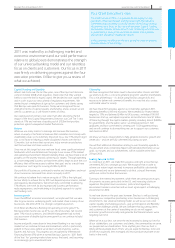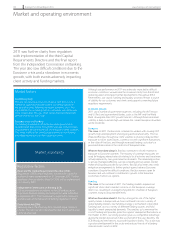Barclays 2011 Annual Report Download - page 19
Download and view the complete annual report
Please find page 19 of the 2011 Barclays annual report below. You can navigate through the pages in the report by either clicking on the pages listed below, or by using the keyword search tool below to find specific information within the annual report.-
 1
1 -
 2
2 -
 3
3 -
 4
4 -
 5
5 -
 6
6 -
 7
7 -
 8
8 -
 9
9 -
 10
10 -
 11
11 -
 12
12 -
 13
13 -
 14
14 -
 15
15 -
 16
16 -
 17
17 -
 18
18 -
 19
19 -
 20
20 -
 21
21 -
 22
22 -
 23
23 -
 24
24 -
 25
25 -
 26
26 -
 27
27 -
 28
28 -
 29
29 -
 30
30 -
 31
31 -
 32
32 -
 33
33 -
 34
34 -
 35
35 -
 36
36 -
 37
37 -
 38
38 -
 39
39 -
 40
40 -
 41
41 -
 42
42 -
 43
43 -
 44
44 -
 45
45 -
 46
46 -
 47
47 -
 48
48 -
 49
49 -
 50
50 -
 51
51 -
 52
52 -
 53
53 -
 54
54 -
 55
55 -
 56
56 -
 57
57 -
 58
58 -
 59
59 -
 60
60 -
 61
61 -
 62
62 -
 63
63 -
 64
64 -
 65
65 -
 66
66 -
 67
67 -
 68
68 -
 69
69 -
 70
70 -
 71
71 -
 72
72 -
 73
73 -
 74
74 -
 75
75 -
 76
76 -
 77
77 -
 78
78 -
 79
79 -
 80
80 -
 81
81 -
 82
82 -
 83
83 -
 84
84 -
 85
85 -
 86
86 -
 87
87 -
 88
88 -
 89
89 -
 90
90 -
 91
91 -
 92
92 -
 93
93 -
 94
94 -
 95
95 -
 96
96 -
 97
97 -
 98
98 -
 99
99 -
 100
100 -
 101
101 -
 102
102 -
 103
103 -
 104
104 -
 105
105 -
 106
106 -
 107
107 -
 108
108 -
 109
109 -
 110
110 -
 111
111 -
 112
112 -
 113
113 -
 114
114 -
 115
115 -
 116
116 -
 117
117 -
 118
118 -
 119
119 -
 120
120 -
 121
121 -
 122
122 -
 123
123 -
 124
124 -
 125
125 -
 126
126 -
 127
127 -
 128
128 -
 129
129 -
 130
130 -
 131
131 -
 132
132 -
 133
133 -
 134
134 -
 135
135 -
 136
136 -
 137
137 -
 138
138 -
 139
139 -
 140
140 -
 141
141 -
 142
142 -
 143
143 -
 144
144 -
 145
145 -
 146
146 -
 147
147 -
 148
148 -
 149
149 -
 150
150 -
 151
151 -
 152
152 -
 153
153 -
 154
154 -
 155
155 -
 156
156 -
 157
157 -
 158
158 -
 159
159 -
 160
160 -
 161
161 -
 162
162 -
 163
163 -
 164
164 -
 165
165 -
 166
166 -
 167
167 -
 168
168 -
 169
169 -
 170
170 -
 171
171 -
 172
172 -
 173
173 -
 174
174 -
 175
175 -
 176
176 -
 177
177 -
 178
178 -
 179
179 -
 180
180 -
 181
181 -
 182
182 -
 183
183 -
 184
184 -
 185
185 -
 186
186 -
 187
187 -
 188
188 -
 189
189 -
 190
190 -
 191
191 -
 192
192 -
 193
193 -
 194
194 -
 195
195 -
 196
196 -
 197
197 -
 198
198 -
 199
199 -
 200
200 -
 201
201 -
 202
202 -
 203
203 -
 204
204 -
 205
205 -
 206
206 -
 207
207 -
 208
208 -
 209
209 -
 210
210 -
 211
211 -
 212
212 -
 213
213 -
 214
214 -
 215
215 -
 216
216 -
 217
217 -
 218
218 -
 219
219 -
 220
220 -
 221
221 -
 222
222 -
 223
223 -
 224
224 -
 225
225 -
 226
226 -
 227
227 -
 228
228 -
 229
229 -
 230
230 -
 231
231 -
 232
232 -
 233
233 -
 234
234 -
 235
235 -
 236
236 -
 237
237 -
 238
238 -
 239
239 -
 240
240 -
 241
241 -
 242
242 -
 243
243 -
 244
244 -
 245
245 -
 246
246 -
 247
247 -
 248
248 -
 249
249 -
 250
250 -
 251
251 -
 252
252 -
 253
253 -
 254
254 -
 255
255 -
 256
256 -
 257
257 -
 258
258 -
 259
259 -
 260
260 -
 261
261 -
 262
262 -
 263
263 -
 264
264 -
 265
265 -
 266
266 -
 267
267 -
 268
268 -
 269
269 -
 270
270 -
 271
271 -
 272
272 -
 273
273 -
 274
274 -
 275
275 -
 276
276 -
 277
277 -
 278
278 -
 279
279 -
 280
280 -
 281
281 -
 282
282 -
 283
283 -
 284
284 -
 285
285 -
 286
286
 |
 |

Our risk management overview
Barclays has clear risk management objectives and a well-established
strategy to deliver them, through core risk management processes.
This enables us to fully understand and minimise the impact of
uncertainty on the business.
For more detailed information, please see the
Risk Management section pages 67 to 158
Board
Board Corporate Governance
and Nominations Committee
Board Citizenship
Committee
Board Risk
Committee
Board Remuneration
Committee
Assurance
Financial Risk Committee
Credit risk Market risk Funding risk Operational risk
Treasury Committee Operational Risk Committee Tax Risk Committee
Authority controls appetite
Reporting and control
Chief Executive
Group Executive Committee
Board Audit
Committee
Four Principal Risks
Credit risk
Credit risk is the risk of the Group suffering financial loss if any of its
customers, clients or market counterparties fails to fulfil their contractual
obligations to the Group. This arises mainly from wholesale and retail
loans and advances together with the counterparty credit risk arising from
derivative contracts entered into with its clients. Other sources of credit
risk arise from trading activities, including debt securities, settlement
balances with market counterparties, available for sale assets and reverse
repurchase loans. This can also arise when an entity’s credit rating is
downgraded, leading to a fall in the value of Barclays investment in its
issued financial instruments.
Market risk
Market risk is the risk of the Group suffering financial loss due to being
unable to hedge its balance sheet at prevailing market levels. The Group
can be impacted by changes in both the level and volatility of prices e.g.
interest rates, credit spreads, commodity prices, equity prices and foreign
exchange rates. The risk is reported as traded risk where Barclays supports
customer activity primarily via Barclays Capital; non-traded risk to support
customer products primarily in the retail bank; and pension risk in relation
to investment returns within the defined benefit scheme.
Funding risk
Funding risk comprises three key risks:
Liquidity risk – the Group is unable to meet its obligations as they fall
due resulting in: an inability to support normal business activity; failing
to meet liquidity regulatory requirements; or changes to credit ratings.
Capital risk – the Group is unable to maintain appropriate capital ratios
which could lead to an inability to support business activity; failing to
meet regulatory requirements; or changes to credit ratings.
Structural risk – management of non-contractual risks and primarily arises
from the impact on the Group’s balance sheet of changes in primarily
interest rates on income or foreign exchange rates on capital ratios.
Operational risk
Operational risk is the risk of direct or indirect impacts resulting from
human factors, inadequate or failed internal processes and systems or
external events. Operational risks are inherent in the Group’s business
activities. The key risks that this principal risk includes are external
suppliers, fraud, financial reporting, information, legal, product, payments,
people, premises & security, regulatory, taxation, technology and transaction
operations. For definitions of these key risks see pages 74 to 78.
Barclays PLC Annual Report 2011 www.barclays.com/annualreport 17
The strategic report Governance Risk management Financial review Financial statements Shareholder information
